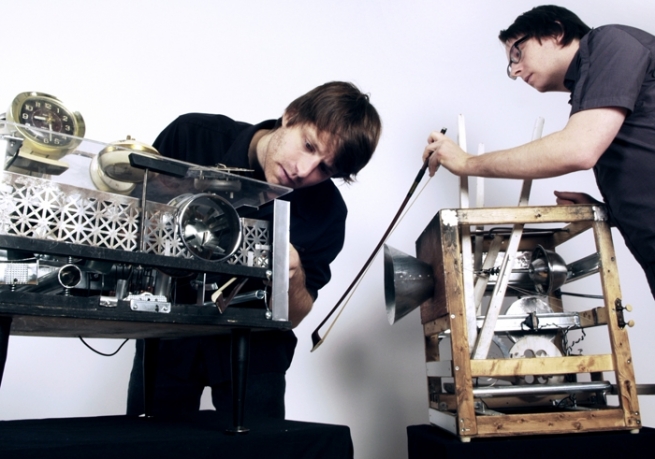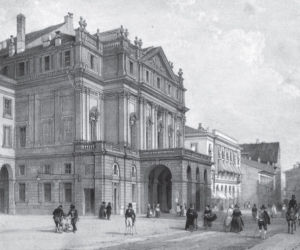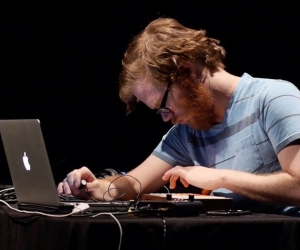
“La chambre des machines is a project where two electronic musicians are driven by the desire to be involved, as physically as they can be, in a performance context,” explains Nicolas Bernier, discussing his ongoing collaborative work with Martin Messier. “It’s not a conceptual piece; it was made in action, from day one.”
The action on stage involves two mechanical boxes. Bernier’s is taller and more old-fashioned in appearance, with a wooden frame and funnel-shaped speaker attached to its front; Messier’s is more squat, housed compactly in metal. Each performer approaches his apparatus like a technician, spotlit in a darkened room. A clock ticks, electronic signals beep, a high tone drones. The twin operatives set to work, tugging levers, turning handles, pulling rods, and twanging springs. Pieces break away from Messier’s machine as he clenches it like a pinball obsessive intensely absorbed in some arcane game. Bernier gazes quizzically, inquiringly, through black-rimmed spectacles into the interior of his machine, then scrapes edgy noise from metal strips with a violin bow, strikes bell-like cups, or taps cogged wheels. The levers judder, the handles grate as they crank, metal rods rattle loudly—some crashing to the floor. All the while, images of machine-like shapes and forms flash and flicker on a backdrop screen.
La chambre des machines arose from the merging of two earlier works by the Montreal-based artists. In 2008, Bernier was commissioned to give a solo performance at a two-day festival in Quebec, celebrating the ninety-fifth anniversary of Luigi Russolo’s Futurist manifesto L’arte dei rumori (The Art Of Noises). With practical assistance from his friend Alexandre Landry, a skilled carpenter, Bernier built a sound machine inspired by Russolo’s intonarumori, noise-making boxes with protruding funnels. “As far as the actual construction of the machine was concerned, Alexandre did pretty much everything himself and had my total trust,” Bernier now recalls. “But Russolo’s intonarumori were closed boxes. You couldn’t see the mechanism inside. I wondered what had motivated this decision. Maybe it was aesthetic: a formal object whose appearance counterbalanced the noisy temperament of the sounds it produced. I wanted to use a mechanical apparatus that actually showed the public how the music is made, physically. This was one of my main visual requirements, even though the sound might then pass through a computer, my main creation tool . . . which is of course another totally enclosed box, like those first intonarumori.”
Boîte, the piece Bernier presented at this event, was developed through a process of discussion and trial and error over a period of six months. Initially, he and Landry tried to conform to five of the sound categories specified by Russolo in L’arte dei rumori: roars, whistling, whispers, screeching, and beating on material. “After some experiments, Alexandre and I moved away from trying to match those categories and just followed our instincts. There was a lot of back and forth between us: Alexandre would show me some experiments, and I would give my thoughts on what I was looking for and what I found interesting. I wanted some percussive noises, for example, and Alex had some difficulty getting that particular kind of sound, but finally we made it.”
Around that time, Messier started performing L’horloger (the clock maker), a solo piece that was inspired by elusive issues of temporality and memory, yet was realized in a vigorously physical way, through Messier’s manipulation of old alarm clocks and their mechanisms. When boîte and L’horloger happened to be programmed on the same concert, Messier and Bernier thought it might be stimulating, illuminating, and fun to find a way to work together. They started to develop a piece taking those solos as their point of departure. As its title La chambre des machines indicates, the prospective concert space became, in their combined imagination, that room in a building where the vital machinery and electronics are lodged. The role of the performers would be to attend and activate these apparatus. La chambre des machines sprang into existence, and more than three years later, they are still finding occasions to perform it.
Bernier and Messier met during the mid-2000s, at the University of Montreal, where both were studying electroacoustic composition. “We used to have intense late-night discussions, barely agreeing on anything,” Bernier recalls. “We had both started out as drummers, but I was more into the smoother side of electroacoustic music—ambient, continuum, field recording; Martin was into the more raw side—distortion, masses, rhythmic sounds. We took different paths, and to be honest I never thought we could ever meet artistically; our ideas were too divergent aesthetically, even though those conversations were really nourishing.”
In retrospect, Bernier suggests that their differences in taste and outlook were effectively resolved in the making of La chambre des machines. The piece brings together and sustains a suspenseful balance between Messier’s rhythmic proclivities and Bernier’s interest in sound matter composed with pure tones. In fact, collaboration with other artists from a wide range of disciplines has been an extremely important means for both men to develop their artistic practices and refine their working methods.
“In a collaboration, the one thing you always do is learn,” Bernier asserts. “And basically, you learn from points of disagreement with your colleague. To work with someone who simply thinks the same as you would be pointless. In this sense, I’ve always found that collaboration expands comprehension, whether I’m working with another composer, performer, choreographer, filmmaker, or poet. Gaining access to different ways of thinking and different expertise is important. Learning about how to move a body in a dance context, or how to put together voices, lights, costume, and set design in a theatre context expands the creative possibilities that are available to me. In any collaboration, the emerging work won’t be one that I would have done myself. And if I had to rethink a collaborative project into a solo one, it would definitely become quite different in the process.”
Messier agrees with Bernier on the value of finding yourself forced to view a shared project within a perspective arising from another discipline, a different training, or an alternative reserve of creative experiences. That unlocking of potential through dislocation of your own established point of view, and the recognition that constraint can often prove enabling seems to be graphically enacted in Messier’s piece Hit and Fall, which he occasionally performs with dancer-choreographer Caroline Laurin-Beaucage. For part of this robust dialogue, Messier plays his drums with characteristic concentration while Laurin-Beaucage struggles to constrain him, to force him away from the kit and into silence. It is a piece, Messier emphasizes, that is less concerned with music in the abstract than with the physicality of drumming.
It would be misleading, however, to suggest that there is some kind of neatly defined dualism in the collaboration between Bernier and Messier. Their creative relationship is far from being so clear-cut. “In previous collaborations, with guitarist Simon Trottier or pianist and accordionist Delphine Measroch, for example, I was the geek of the duet,” Bernier points out. “So I was the one programming, editing, and mastering while they were playing their instruments. With Martin, it’s the other way around: he is a far more advanced programmer than I am. And I find that because I’m not programming in La chambre des machines, it leaves a bit more headspace for me to actually listen and to comment upon what we are doing.”
“I truly love what I can create with a computer,” Messier acknowledges, “but when I go to a venue at night I don’t necessarily like to see someone sitting behind a computer. So, I’ve had to imagine ways to present my music live and that leads me to materialize sounds, while performing, by means of objects or dancers. In my work the computer is never shown.”
It is this sense of the aesthetic inadequacy of certain performance practices current in the field of electronic music, this shared aversion to concert priorities that are visually depleted or even disembodied that has brought Bernier and Messier together so forcefully.
“The very reason I chose to do electroacoustic music is because I feel that it makes everything possible,” Bernier affirms. “It gives you unlimited access to the sound world, and I need that freedom. But I don’t see why my work should be limited to sound. I’ve always had an interest in the visual, even though I tend to work a lot less with photography, video, or graphic design. For me, it’s not that important to do music. I just do work, and people will take from that what they want. With the term music, I always feel there’s a historical burden floating around. Our way of thinking is wider than just viewing things in terms of musicality. We think of gestures, lighting, movement, interaction, scenography.”
Messier agrees. “I don’t necessarily think in terms of art forms, when I am working,” he says. “That’s not a concern for me. I prefer to think in terms of means of realization, to think that this project will be better if I use this, this, and this . . . Sound is always my starting point—it’s where I am coming from—but what I am really aiming for is to de-contextualize electronic and electroacoustic music. La chambre des machines is not just about sound. It’s really evident that it is a performance, and not a piece of music in itself. It simply wouldn’t be interesting to listen to on CD, without the visual dimension.”
The first presentation of La chambre des machines, at Transmediale, Berlin, in 2010, didn’t include a video element. Later that year, at Montreal’s Mutek festival, in a larger venue, Bernier and Messier decided to add the video backdrop. They were dissatisfied with the initial outcome, but continued to develop the backdrop as an integral part of the piece. “It was initially a video of fixed duration,” Bernier explains. “There was no interactive component, and it wasn’t much in sync with the music. We reworked the video visuals so they were completely synchronized when we presented the piece at Sonar in Barcelona. And then, in 2011, we decided to make it interactive for our show at the Ars Electronica festival at Linz, Austria. Now we had to use two computers—one for sound, one for video. The video can vary in two ways: there are random algorithms so that images are never triggered in exactly the same order; also, if we play smoothly there will be fewer images, while if we play like crazy, without stopping, the images will respond and go crazy too.”
Although their realization of this piece has the edgy, focused, yet exploratory feel of an entirely improvised performance, strictly speaking it is not improvised at all. “The form is fixed,” Bernier continues. “There is a precise timeline that we have to follow, and by now we have come to know the score perfectly. We press ‘play’ on our computer at the beginning of the performance, and from that moment we can’t pause. The computer provides a basic electronic track, with some rhythmic elements that are not possible for us to do in real time, as our instruments are not sufficiently precise. It also supplies a few sound cues, so we know when the next section is coming and that we will have to stop or start in, say, four bars.
“There’s some real-time processing too, always at the same points in the timeline. If at a certain moment there is reverb or distortion on my machine, I have to be aware of that and adjust my interpretation in line with the processing. The electronic score is written, yet we do have some freedom in the way we play, varying the intensity, the density of events; and our gestures, our physical movements, trigger prerecorded samples. By the end, we are really fighting with our instruments, and we always have to repair them afterwards. But the element of theatricality in this work can also be subtle, brought out in small things like the positioning of lights, or the effect of a specific gel that we apply to them.”
Bernier and Messier are committed to sensuous and muscular performance, but more than that, they aim—whether working together or independently—to preserve a sense of the physical properties of objects and of human bodies amid the ambiguous realities of digital flux and virtual worlds. “I arrived in electronic music exactly at the shifting point between the analog and the digital eras, and this had a tremendous impact on my work,” Bernier observes. “In fact, my immediate reaction was to work against the notion of this “everything-is-now-digital” world. Even though I have always been astonished by the laptop’s capabilities, I’m attracted by obsolete objects, and I like to have physical contact with them.
“I’m a bit of a collector. My soundworks have often been constructed with collections of sounds coming from collections of actual objects, such as typewriters, antique toys, and tuning forks. My interest in the technological legacy of the industrial revolution, old mechanical apparatus, is growing stronger than ever, despite the fact that in a way I am so far from it, in the digital age. For me, this is a way of escaping the contemporary art world’s pressure to be ‘contemporary’.” In cultural theorist Jean Baudrillard’s book Le Système des objets (The System of Objects, 1968) Bernier found reference to “un phénomène qui accompagne souvent la passion de collectionneur, c’est la perte du sentiment du temps actuel” [a phenomenon that often accompanies the collector’s passion—loss of a sense of current time]. “That is exactly where I stand,” says Bernier.
“A lot of my musique concrète has been based on mechanical objects.” So, Bernier’s eight-channel acousmatic composition Writing Machine (2005), inspired by William Burroughs and Brion Gysin’s literary cut-up technique, derives most of its nonvocal sound material from a mechanical typewriter; its shrill bell, ratcheting carriage, and percussive keys. A version of Writing Machine can be heard on Bernier’s 2007 release Travaux mécaniques (empreintes DIGITALes). That CD also features his Liaisons mécaniques (2007), which draws on the evocative sounds of obsolete cameras, film projectors, music boxes, and mechanical toys, their whirring cogs and crunching gears processed into a stream of granular textures and grainy fine detail.
“We are now moving away from the analog–digital dichotomy,” Bernier suggests. “So we can talk about the content instead of just the means . . . which is good news. My recent solo performance frequencies (a) uses tuning forks that I activate with motors. For me, tuning forks are a strong link between the old and the new technologies, the old and the new music, acoustic and electronic sound. We are all living and working in between, and that’s the beauty of our situation.” In a performance of frequencies (a), the sound of Bernier’s motor-driven tuning forks is combined with pure digital sound waves. His actions trigger sequences from the computer that activate solenoids, so that the forks are struck with high precision. Streams of light accompany the release of their sound.
“I’m just fascinated when I think that there were acousticians in the late 1800s who worked on building acoustic synthesizers made with such tuning forks. This is the kind of idea that drives me,” Bernier enthuses. “Generally, I’m fascinated by the beginning of things—Helmholtz’s experiments in the field of acoustics, for example. Pierre Schaeffer’s pioneering studies are my favourite musique concrète, and Stockhausen’s studies in electronic [music]. And of course, Luigi Russolo is of great importance when we speak about invented instruments.”
When they determined to proceed as a duo with La chambre des machines, a second Russolo-inspired machine was obviously needed for Messier’s use. “We more or less gave Alexandre Landry carte blanche, as we were short of time and needed an instrument,” Bernier recalls. “The main constraint was that we wanted an amplified metal plate on top, so that Martin could play with his old-fashioned clockworks. Of course, La chambre des machines is about mining the intrinsic sonic possibilities of our acoustic instruments, but it is also about exploring the ambiguous relationship between acoustic and synthetic sound, the correlation between the gestures of the players and the resulting sounds, about the visual dimension, about the light, the scenography, the energy curves on stage.”
In Messier’s compelling Sewing Machine Orchestra (2010), computer processing transforms the functional sounds of eight 1940s Singer sewing machines, mounted on stands, into a vivid, dancing weave of hums, whirrs, and beats, accompanied by suitably pulsating lights. The imaginative involvement shared by him and Bernier with everyday technologies of the pre-digital age should not be mistaken for a form of wistful nostalgia. In Laws Of Media (1988) Marshall and Eric McLuhan suggest that “the artist is the person who invents the means to bridge between biological inheritance and the environments created by technological innovation.” Bernier and Messier are deeply involved in just that kind of inventiveness, investigating the impact and implications of changing technological environments in relation to our aesthetic, analytic, and physical engagements with reality.
Audio: Liaisons mécaniques (2006–07) 10:06. Composed by Nicolas Bernier. From the album Travaux mécaniques (empreintes DIGITALes, IMED 12114). Licensed courtesy of YMX Media and Nicolas Bernier through SODRAC. Image: Martin Messier and Nicolas Bernier perform La chambre des machines. Image by: Isabelle Gardner


